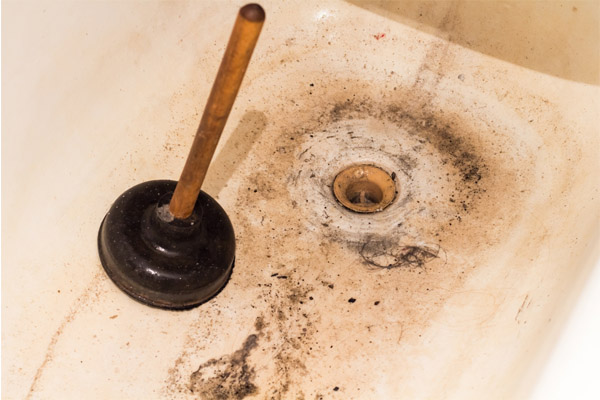Investigating the Phenomenon of Waste Rising Through the Bathtub
Investigating the Phenomenon of Waste Rising Through the Bathtub
Blog Article
What are your opinions regarding Water Coming up Bathtub Drain?

Sewage backup in the bathtub can be a traumatic and unhygienic issue for any kind of property owner. Not only is it bothersome, but it also postures significant wellness threats and shows underlying concerns with the plumbing system. Understanding why sewer is showing up with the bath tub is essential for taking appropriate activity to deal with the issue properly.
Introduction to the Issue
Typical Reasons for Sewage Back-up
Clogs in the Sewage System Line
Among the most common root causes of sewer back-up is a clog in the sewer line. This can occur because of the accumulation of particles, oil, or international items in the pipes, stopping appropriate flow and causing sewer to support into your bath tub.
Tree Root Intrusion
Tree roots looking for wetness and nutrients can infiltrate drain lines with tiny cracks or joints. With time, these origins can grow and broaden, causing significant damages to the pipelines and causing sewer backup problems.
Recognizing the Problem
When sewer starts backing up into the tub, it's a clear sign of a problem with the drainage system. The wastewater that needs to be moving far from your home is instead locating its back right into your home, which can cause substantial damage and health hazards.
Potential Causes
A number of variables can contribute to sewage backup in the bathtub. From obstructions in the sewer line to issues with the plumbing infrastructure, identifying the origin is essential for finding a remedy.
Aging Framework
Older homes may have outdated plumbing systems that are more at risk to corrosion, cracks, and deterioration. As pipes age, they become a lot more prone to leaks and clogs, raising the possibility of sewage backup events.
Heavy Rainfall or Flooding
Throughout periods of heavy rainfall or flooding, the sewer system might end up being overwhelmed with excess water, triggering backups and overflows. This can result in sewage backing up right into tubs and various other fixtures inside the home.
Indicators of Sewer Backup
Foul Odors
Unpleasant odors rising from drains pipes or fixtures, specifically in the bathroom, may indicate sewer backup concerns. These smells are frequently solid and relentless, signifying a trouble that requires immediate focus.
Slow Draining Fixtures
Tubs, sinks, and toilets that drain slowly or otherwise in any way could be experiencing sewer backup. If several components are affected simultaneously, it's most likely that the problem stems from a typical point, such as the major sewage system line.
Gurgling Noises
Unusual gurgling or gurgling sounds originating from drains when water is running somewhere else in the house are a measure of air entraped in the plumbing system. This air build-up can result from sewer backup and ought to be investigated quickly.
Wellness Risks Associated with Sewer Back-up
Contamination of Water System
Sewage back-up can contaminate the water system in your house, posing a significant health threat to you and your family. Exposure to polluted water can result in intestinal problems, skin infections, and other illnesses.
Mold and mildew Development
Dampness from sewer back-up can develop optimal problems for mold development in your home. Mold and mildew spores can exacerbate respiratory troubles and trigger allergic reactions in delicate people, making timely cleaning important.
Spread of Disease
Sewage has harmful microorganisms, viruses, and bloodsuckers that can create a range of conditions, consisting of liver disease, cholera, and gastroenteritis. Coming into contact with sewage or infected surface areas places you at risk of infection.
Cleaning Up After Sewer Backup
Disinfection Procedures
Extensively decontaminate and sanitize affected locations after sewage backup to get rid of damaging germs and prevent mold growth. Usage appropriate cleansing products and protective equipment to ensure secure and reliable cleanup.
Reconstruction of Impacted Locations
Repair any kind of damage to floor covering, walls, or fixtures triggered by sewage back-up. Relying on the degree of the damage, you may need to replace carpeting, drywall, or various other products to recover your home to its pre-loss problem.
Immediate Actions to Take
Switching Off Water
In case of sewage backup, it's important to switch off the water supply to avoid further contamination and damage. Situate the major water shutoff valve in your home and closed it off up until the issue can be solved.
Calling a Specialist Plumber
Taking care of sewer backup is not a do it yourself task. Contact a licensed plumber with experience in dealing with sewage-related concerns to analyze the circumstance and perform essential repair work or cleanups.
Preventing Contact with Contaminated Water
Until the sewage back-up is resolved, stay clear of contact with infected water to prevent the spread of germs and pathogens. Wear safety equipment if you should be in the affected area and clean your hands thoroughly later.
Safety nets
Normal Maintenance of Sewer Lines
Set up normal examinations and upkeep of your drain lines to identify and deal with potential problems prior to they rise into major troubles. This can include cleaning debris, checking for tree origin breach, and fixing any kind of damaged pipes.
Setting Up Backwater Shutoffs
Think about installing bayou shutoffs in your plumbing system to prevent sewer from flowing back into your home during periods of heavy rainfall or flooding. These valves automatically close when water draws back up, securing your building from contamination.
Appropriate Disposal of Family Waste
Stay clear of purging anything other than toilet paper and human waste down the bathroom to prevent obstructions and clogs in the sewer line. Dispose of oil, oil, and other home chemicals correctly to reduce the risk of plumbing problems.
Why is there sewage coming up from my bathtub?
These gas fumes, like hydrogen sulfide – the gas that leaves a rotten egg smell in its wake and is highly flammable and toxic – can be hazardous to your health. Sewage poses major health risks as it contains harmful bacteria and microorganisms that can be dangerous if exposed to them.
Sewage cleanup should be considered an emergency.
So, why is there sewage coming up from your bathroom? There are several common causes of a sewage backup.
The most common reason for sewage coming up through your bathroom is a clogged sewer line. All plumbing in your bathroom connects to a single drain pipe that leads to the sewer line under your house. This drain line carries all wastewater and sewage away from your home to the city’s sewer system.
When the sewer line becomes clogged or blocked, wastewater has nowhere to go but back toward your house. This results in sewage coming up through your drains, often starting with your tub or shower.
Another culprit may be the sewage ejector pump, which is used when a bathroom, laundry room or any other type of plumbing fixture is located below the level of the main sewer or septic line flowing from the house. Most commonly, ejector pumps are used in homes with basement bathrooms or laundry rooms.
When you experience sewage coming up through your bathtub, it’s always best to contact a professional. Attempts to fix a clogged sewer line without experience often lead to more plumbing damage.
Make sure that no one enters the affected area, and open as many windows as possible. Pre-treat the flooded area with small splashes of chlorine bleach. Wear protection gear like rubber gloves, a mask, and water-resistant coveralls.
https://www.shawlocal.com/the-herald-news/sponsored/2022/08/17/omega-plumbing-10199038/

As an enthusiastic reader on What To Do If Sewage Starts Backing Up Into the Shower, I think sharing that blog post was necessary. Feel free to take a moment to distribute this page if you enjoyed reading it. Thanks so much for your time spent reading it.
Contact
Report this page